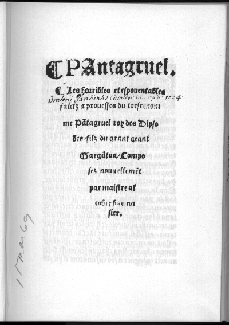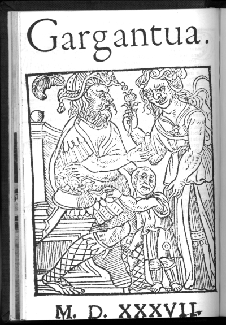"Pantagruel", "GargAntua"
- Artist/Author/Producer: Rabelais, François (1494-1553)
- Confronting Bodies: The divines of the Sorbonne, French parliament, U.S. Custom Department,
South African State.
- Dates of action: 1533+
- Location: France, Italy, South Africa, US


- Description of the Art Work
-
"Pantagruel" 1533: The story of Pantagruel, the giant, son of GargAntua,
their feats, their wars and adventures. The framework of a mock-heroic
chivalrous romance, he laughed at many types of sophistry including the
legal obsurantism and hermeticism, which he nevertheless preferred to the
scholasticism of the SOrbonne. In one chapter, he praises the divine gift
of fertile matrimony as compensation for death caused by Adam's fall.
"GargAntua" 1535: The story of Pantagruel, the giant, son of GargAntua,
the giant, their feasts, their wars and adventures. Supports royalist
causes espoused by Jean du Bellay, who had been created by the Cardinal
and essentially by King Francis I. Rabelais preaches steadfastness in
face of persecution.
- Description of incident
- 1533 France: The first of two parts of "Pantagruel", published without
the knowledge of the author, were listed on the "Index" of the Sorbonne
and on the Official black list of parliament.
1546 France: The Third book of "Pantagruel" was published under the
author's name "avec privilège du Roi" .
1564 Italy-Rome: The "Index" listed Rabelais in its severe first class
as "Rebelisius"
- Results of incident
- 1535 Italy-Rome: A Papal bull absolved Rabelais from ecclesiastical
censure.
1552 France: Taking advantage of the King's absence from Paris, the
divines of the Sorbonne censored the fourth book on publication.
1554 France: Cardinal de Chatillon persuaded Henry II to raise the ban on
the works of Rabelais.
1930 United States: The customs Department lifted the ban on all editions
with the exception of those with so-called obscene illustrations,
specifically Frank C. Pape's drawings for an edition of the Motteux
translation.
1938 South Africa-Johannesburg: All works banned.
Banned Books 387 B.C. to 1978 A.D., by Anne Lyon Haight, and Chandler B.
Grannis, R.R. Bowker Co, 1978.


